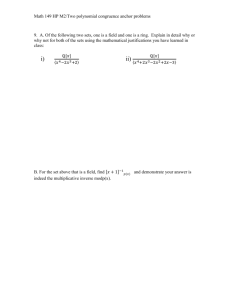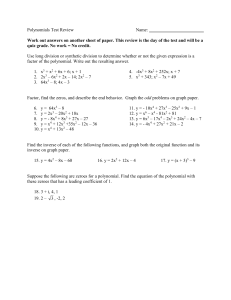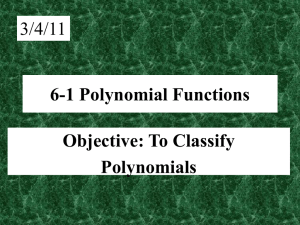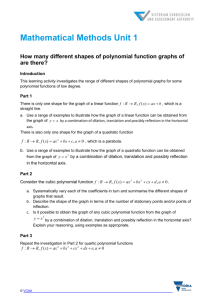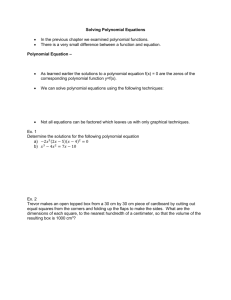BBA120 Business Mathematics
advertisement
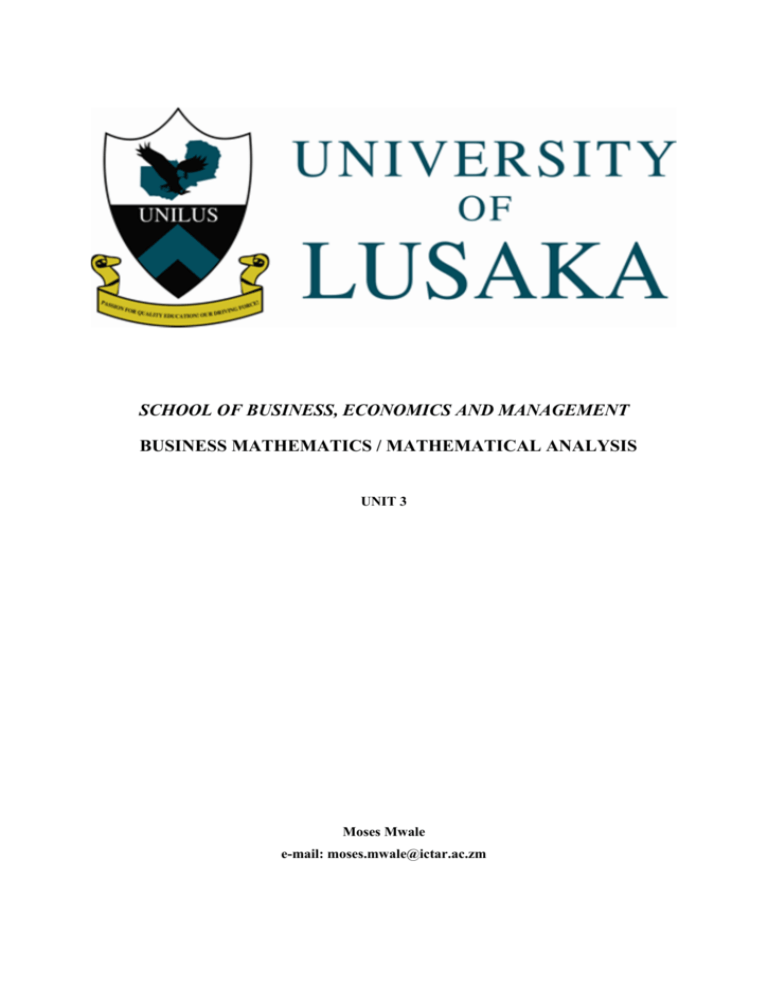
SCHOOL OF BUSINESS, ECONOMICS AND MANAGEMENT
BUSINESS MATHEMATICS / MATHEMATICAL ANALYSIS
UNIT 3
Moses Mwale
e-mail: moses.mwale@ictar.ac.zm
BBA 120 Business Mathematics
Contents
Unit 3: Functions and Graphs
3
3.0 Functions ..................................................................................................................... 3
3.1 Inverse Functions .............................................................................................. 4
Example ................................................................................................. 4
Practice Problems .................................................................................. 5
3.2 Composite Functions. ........................................................................................ 5
3.3 Special Functions .............................................................................................. 8
3.3.1 Constant Functions................................................................................ 8
3.3.2 Polynomial Functions ........................................................................... 8
3.3.3 Rational Functions ................................................................................ 9
3.3.4 Compound Functions ............................................................................ 9
Example ............................................................................................... 10
3.3.5 Absolute Value Function ................................................................... 10
Example ............................................................................................... 10
BBA 120 Business Mathematics
Unit 3: Functions and Graphs
3.0 Functions
Given two arbitrary sets X and Y, a function from X to Y is a rule which
assigns one member of Y to each member of X.
Notation
A function f with domain X and codomain Y is commonly denoted by
𝑓: 𝑋 → 𝑌
or
The above diagram
represents a function
with domain {1, 2, 3},
codomain {A, B, C, D}.
𝑓
𝑋→𝑌
In our function above, the elements of X are called arguments of f.
the set "X" is called the Domain,
the set "Y" is called the Codomain, and
the set of elements that get pointed to in Y (the actual values
produced by the function) is called the Range.
For each argument x, the corresponding unique y in the codomain is
called the function value at x or the image of x under f. It is written as
f(x).
However this second
diagram does not
represent a function
since 2 is the first
element in more than
one ordered pair.
One says that f associates y with x or maps x to y. This is abbreviated by
𝑦 = 𝑓(𝑥)
Example
If X and Y are both the set ℝ, the rule which says ‘multiply by 2’ is a
function.
Normally we express this function by a formula. If we call the function f
we can write the rule which define 𝑓(𝑥) = 2𝑥.
It is worth noting that when we can define f in this way the 𝑥 is a ‘dummy
variables, the function could equally well be defined by writing
𝑓(𝑦) = 2𝑦, or 𝑓(𝑡) = 2𝑡 or even 𝑓(𝑏𝑙𝑜𝑏) = 2𝑏𝑙𝑜𝑏.
The point is that f is the function which doubles any value.
The symbol used to denote a typical real number in the domain of a
function is called the independent variable. The symbol used to denote
the typical real number in the range is called the dependent variable.
3
4
Unit 3: Functions and Graphs
It is often helpful to think of a function as a ‘black box’ which converts
an input into output (Figure 3.1). If the name of the function is 𝑓 then
𝑓(𝑥) is the output corresponding to a given input 𝑥.
The box may represent any rule such as ‘multiply by 2’, or ‘add 23’, or
‘square’, provided. Only that for each input there is a unique, welldefined output.
𝑥
Figure 3.1:
𝑓(𝑥)
𝑓
Diagrammatic representation of a function.
The diagram is useful because it stresses that a function is a one-way
relationship, signified by the direction of the arrows.
Sometimes it may not be possible to reverse the arrows that is, the output
may not determine the input. For example, if the function if the ‘square’
function, so that 𝑓(𝑥) = 𝑥 2 , and the ‘output’ of the box is 4, we do not
know whether the input was 2 or 2, either of which would give the same
value.
3.1 Inverse Functions
If 𝑓is a function for which it is possible to reverse the arrows, the
resulting ‘reverse’ function is called the Inverse function for 𝑓 and is
denoted by 𝑓 −1 so if, then 𝑥 = 𝑓 −1 (𝑦)
𝑥
𝑦
𝑓
𝑦
𝑓 −1
Figure 3.2. A function and its inverse.
Example
Suppose f is given by the formula 𝑓(𝑥) = 2𝑥 + 7 so that when the input
is x the output is 𝑦 = 2𝑥 + 7.
To obtain a formula for the inverse function we have to find out what
value of x will give a particular y, and we can do this simply by
7
reorganizing the equation 𝑦 = 2𝑥 + 7 into the form 𝑥 = (𝑦 − 2).
This uniquely determines x in terms of y, so here we have the inverse
function 𝑓 −1 given by the formula.
7
𝑓 −1 (𝑦) = (𝑦 − 2)
𝑥
BBA 120 Business Mathematics
Note that if f and g are functions such that g is the inverse of f, then f is
the inverse of g.
For 𝑦 = 𝑓(𝑥) if and only if 𝑥 = 𝑔(𝑦) by the definition of 𝑔 = 𝑓 −1 .
Here 𝑥 and 𝑦 are any values, and their names are irrelevant.
So we may interchange the names, giving 𝑦 = 𝑔(𝑥) if and only if 𝑥 =
𝑓(𝑦) and this is just the condition that 𝑓 = 𝑔−1 .
If 𝑓 has an inverse function 𝑓 −1 , one can think of 𝑓 −1 as the ’undoing’
of 𝑓 in the sense that if we take 𝑥 and form 𝑦 = 𝑓(𝑥) and then apply 𝑓 −1
to, 𝑦 we obtain 𝑥 again.
For example, consider again the previous example. Here
7
f ( x) 2 x 7 and f 1 ( y ) ( y ).
2
For any
𝑓 −1 (𝑓(𝑥)) = 𝑓 −1 (2𝑥 + 7) =
(2𝑥 + 7) − 7 2𝑥
=
=𝑥
2
2
Thus, for any 𝑥,
𝑓 −1 (𝑓(𝑥)) = 𝑥 ,
The observation just made concerns following the action of 𝑓 by that of
𝑓 −1 .
The notion of apply one function directly to the output of another is an
important one and can be made precise, as follows.
Practice Problems
1. Given 𝑓(𝑥) = 3𝑥 − 2 find 𝑓 −1 (𝑥)
2. Given 𝑔(𝑥) = √𝑥 − 3 find , 𝑔−1 (𝑥)
𝑥+4
3. Given ℎ(𝑥) = 2𝑥−5 find ℎ−1 (𝑥).
3.2 Composite Functions.
Composition functions are used to combine the two functions. If A, B and
C be any three sets and 𝑓: 𝐴 → 𝐵 and 𝑔: 𝐵 → 𝐶 be any two functions,
then the domain of g is the co-domain of 𝑓.
5
6
Unit 3: Functions and Graphs
The composition of functions f and g is denoted by "𝑔 𝑜 𝑓" or we can say
that the function g o f is called the composition of two functions f and g.
Definition
Let 𝑓: 𝐴 → 𝐵 and 𝑔: 𝐵 → 𝐶 be two functions. Then, the
composition of functions f and g denoted by "g o f".
𝑔 o 𝑓 is read as 𝑔 of 𝑓.
The new function (𝑔 𝑜 𝑓): 𝐴 → 𝐶 such that (𝑔 𝑜 𝑓) (𝑎) =
𝑔(𝑓(𝑎)) for all 𝑎 ∈ 𝐴. Here, 𝑓(𝑎) is an element of B. Therefore,
𝑔(𝑓(𝑎)) is meaningful.
The function 𝑔 𝑜 𝑓: 𝐴 → 𝐶 given by 𝑔 𝑜 𝑓(𝑎) = 𝑔(𝑓(𝑎)) for all
"a" belongs to A.
This is illustrated in the diagram below
Figure 3.3: A composite Function.
A composite function is sometimes called ‘function of a function’.
Given three functions 𝑓, 𝑔, ℎ, the composite 𝑓 ∘ 𝑔 ∘ ℎ, is defined to be
𝑓(𝑔 ∘ ℎ). In other words, we first form ℎ followed by 𝑔 and then form
the composite of this function (𝑔 ∘ ℎ). followed by 𝑓.
Note that composition of a function is an associative operation.
Examples:
1.
Let A = {1, 2}, B = {3, 4} and C = {5, 6} and 𝑓: 𝐴 → 𝐵 and 𝑔: 𝐵 → 𝐶
such that f(1) = 3, f(2) = 4, g(3) = 5, g(4) = 6. Find g o f.
Solution:
BBA 120 Business Mathematics
g o f is a function from A → C. Identify the images of elements of A
under the function g o f.
Domain for g = {f(1), f(2)}
(g o f) (1) = g(f(1)) = g(3) = 5
(g o f) (2) = g(f(2)) = g(4) = 6
i.e. image of 1 is 5 and image of 2 is 6 under g o f. That is, g o f = {(1, 5),
(2, 6)}.
2. The two functions f, g are defined by 𝑓(𝑥) = 𝑥 2 + 1, 𝑔(𝑥) = 𝑥 − 1.
Find 𝑓 𝑜 𝑔 and 𝑔 𝑜 𝑓 and show that 𝑓 𝑜 𝑔 ≠ 𝑔 𝑜 𝑓.
Solution:
Given functions are f(x) = x2 + 1, g(x) = x - 1
(f o g) (x) = f(g(x)) = f(x - 1) = (x - 1)2 + 1 = x2 - 2x + 2
(g o f) (x) = g(f(x)) = g(x2 + 1) = (x2 + 1) - 1 = x2
Thus, (f o g) (x) = x2 - 2x + 2
(g o f) (x) = x2
fog≠gof
3. The two function f and g are f(x) = 3x, g(x) = x + 1. Find g o f.
Solution:
Given f(x) = 3x, g(x) = x + 1
g o f = g(f(x) = g(3x) = 3x + 1
g o f = 3x + 1
7
8
Unit 3: Functions and Graphs
Example
Suppose that
3
f ( x)
1
, g ( x) x 2 and h( x) x 2 2 x 3. Then
x
3
2
3
2
( g h)( x) g ( x 2 x 3) ( x 2 x 3) and ( f g h)( x) f ( x 2 x 3) )
2
2
1
( x 2 x 3)
2
3
2
3.3 Special Functions
3.3.1 Constant Functions
Let ℎ(𝑥) = 2. The domain of ℎ is all real numbers. All function values
are 2. For example ℎ(10) = 2, ℎ(−328) = 2, ℎ(𝑥 + 3) = 2
We call ℎ a constant function because all the function values are the
same. More generally, we have this definition.
A function of the form ℎ(𝑥) = 𝑐 where C is a constant function is called
a constant function.
3.3.2 Polynomial Functions
A constant function belongs to a broader class of functions, called
polynomial functions.
In general, a function of the form
𝑓(𝑥) = 𝐶𝑛 𝑥 𝑛 + 𝐶𝑛−1 𝑥 𝑛−1 + ⋯ + 𝐶1 𝑥 + 𝐶0 ,
where n is a nonnegative integer and 𝐶𝑛 , 𝐶𝑛−1 … 𝐶0 are constants with
𝐶𝑛 ≠ 0 is called a polynomial function (in 𝑥).
The number 𝑛 is called the degree of polynomial, and 𝐶𝑛 is the leading
coefficient.
Thus 𝑓(𝑥) = 3𝑥 2 − 8𝑥 + 9 is a polynomial function of degree 2 with
leading coefficient 3.
Likewise 𝑔(𝑥) = 4 − 2𝑥 has degree 1 and leading coefficient 2.
Polynomial functions of degree 1 or 2 are called linear or quadratic
functions, respectively. Hence 𝑔(𝑥) = 4 − 2𝑥 is linear and 𝑓(𝑥) =
3𝑥 2 − 8𝑥 + 9 is quadratic.
2
BBA 120 Business Mathematics
Note that a nonzero constant function such as 𝑓(𝑥) = 5 [which can be
written as (𝑥) = 5𝑥 0 ], is a polynomial function of degree 0.
Examples
a. 𝑓(𝑥) = 𝑥 3 − 6𝑥 2 + 7 is a polynomial (function) of degree 3 with
leading coefficient 1.
b. 𝑔(𝑥) =
2𝑥
3
2
is a linear function with leading coefficient 3.
2
c. 𝑓(𝑥) = 𝑥 3 is not a polynomial function, because 𝑓(𝑥) = 2𝑥 −3
and the exponent for 𝑥 is not a nonnegative integer.
1
Similarly, 𝑔(𝑥) = √𝑥 is not a polynomial because 𝑔(𝑥) = 𝑥 2
3.3.3 Rational Functions
𝑎
A function written in the form of 𝑏 is called rational function, 𝑓(𝑥) =
𝑝(𝑥)
,
𝑞(𝑥)
where 𝑝(𝑥) and 𝑞(𝑥) are polynomial functions.
Example
a) 𝑓(𝑥) =
𝑥 2 −6𝑥
𝑥+5
Note that this rational function is not defined for
𝑥 = −5 , since division by 0 is not defined.
b) 𝑔(𝑥) = 2𝑥 + 3 is a rational function since
2𝑥+3
1
= 2𝑥 + 3
In fact, every polynomial function is also a rational function.
3.3.4 Compound Functions
1, if 1 s 1
Let f ( s )
0 If 1 s 2
s 3, if 2 s 8
This is called a compound function because the rule for this function is
given by more than one expression.
Here 𝑠 is the independent variable and the domain 𝑓 is all 𝑠 such that
−1 ≤ 𝑠 ≤ 8
9
10
Unit 3: Functions and Graphs
Example
Find 𝑓(0), 𝑓(2) and 𝑓(7)
Answers
𝑓(0) and 𝑓(2) = 0, 𝑓(7) = 4
3.3.5 Absolute Value Function
The function 𝑓(𝑥) = |𝑥| is called the absolute value function.
Recall that the absolute value or magnitude, if a real number 𝑥 is denoted
|𝑥| and is defined by
x
x, if x 0
x, if x 0
Thus the domain of 𝑓 is all real numbers.
Some function values are:
f (16) 16 16
4 4
4 4
f
3
3
3 3
f (0) 0 0
Example
Solve |𝑥 − 3| = 2 solving this gives 𝑥 = 5 𝑜𝑟 1
Exercise
1. Using the graph of the function f:
BBA 120 Business Mathematics
(a) Find the domain and the range of 𝑓
(b) List the intercepts.
(c) Find 𝑓(1)
(d) For what value(s) of x does 𝑓(𝑥) = −3?
(e) Solve 𝑓(𝑥) < 0
2. Consider the function 𝑔(𝑥) = {
2𝑥 + 1
𝑥−4
𝑖𝑓 𝑥 < −1
𝑖𝑓 𝑥 ≥ −1
(a) Graph the function.
(b) List the intercepts.
(c) Find 𝑔(−5)
(d) Find 𝑔(2)
3. For the function 𝑓(𝑥) = 3𝑥 2 − 2𝑥 + 4, find the average rate of change of f
from 3 to 4.
4. For the functions 𝑓(𝑥) = 2𝑥 2 + 1 and 𝑔(𝑥) = 3𝑥 − 2, find the following and
simplify:
(a) 𝑓 − 𝑔
(b) 𝑓 ∙ 𝑔
(c) 𝑓(𝑥 + ℎ) − 𝑓(𝑥)
5. Graph each function using the techniques of shifting, compressing or
stretching, and reflections. Start with the graph of the basic function and show
all stages.
(a) ℎ(𝑥) = −2(𝑥 + 1)3 + 3
(b) 𝑔(𝑥) = |𝑥 + 4| + 2
6. The variable interest rate on a student loan changes each July 1 based on the
bank prime loan rate. For the years 1992–2007, this rate can be approximated
by the model 𝑟(𝑥) = −0.115𝑥 2 + 1.183𝑥 + 5.623, where x is the number of
years since 1992 and r is the interest rate as a percent.
(a) Use a graphing utility to estimate the highest rate during this time period.
During which year was the interest rate the highest?
(b) Use the model to estimate the rate in 2010. Does this value seem
reasonable?
7. Imagine a dance at which there are 15 boys and 15 girls. Every boy writes his
name on a slip of paper, and then puts the slip into a jar. (No two boys have
the same name.) The girls pick slips out of the jar, one at a time and one for
each girl, to determine who their dance partner will be. If we think of this
action as a mapping from the set of boys to the set of girls, what type of
mapping is this?
8. Imagine another dance at which there are 10 boys and 15 girls. Every girl
writes her name on a slip of paper, and then puts the slip into a jar. (No two
girls have the same name.) The boys pick slips out of the jar, with every other
11
12
Unit 3: Functions and Graphs
boy taking two slips instead of only one, so all the slips get taken. This
determines how the dance partners will be assigned. Five of the boys end up
dancing with one girl, but the other five have to contend with two girls! If we
think of this action as a mapping from the set of boys to the set of girls, what
type of mapping is it?
